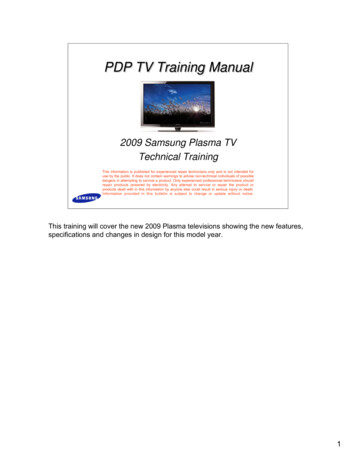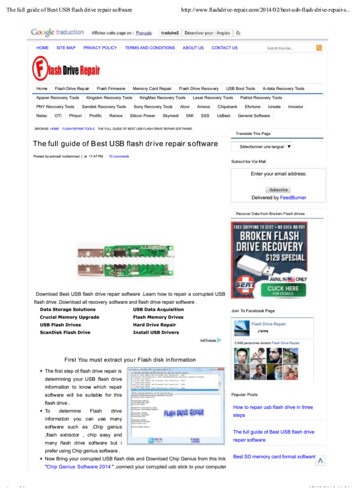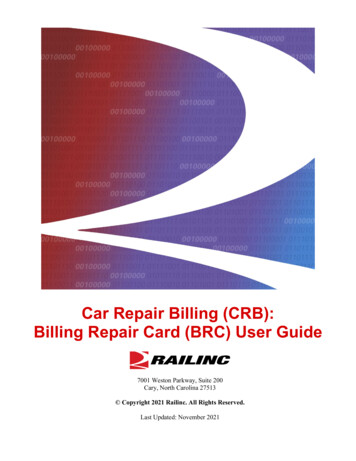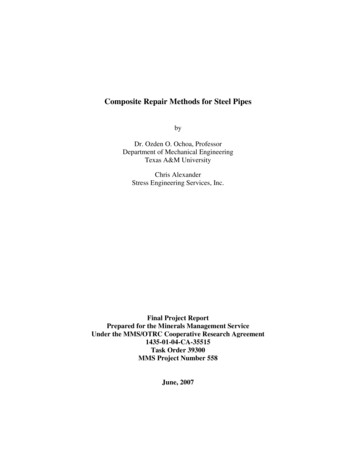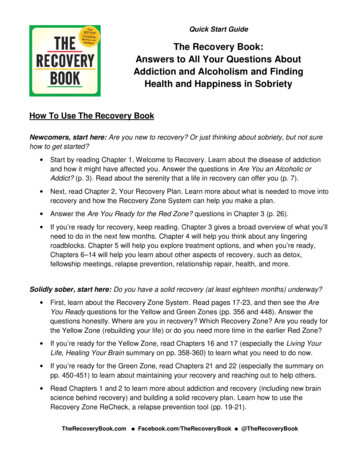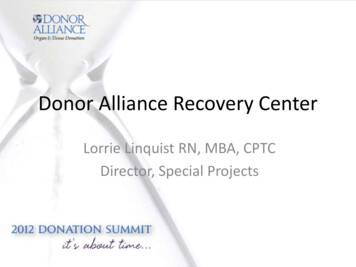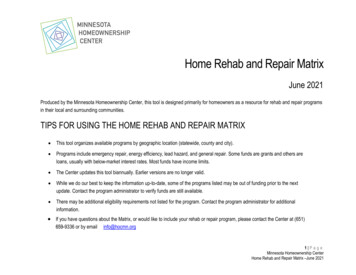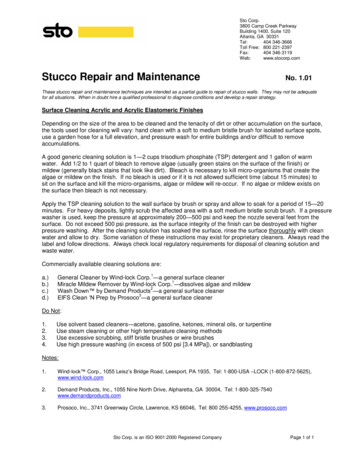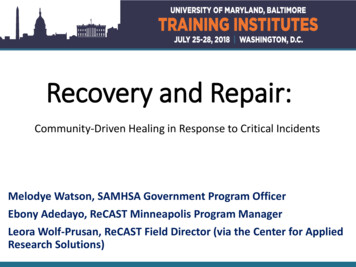
Transcription
Recovery and Repair:Community-Driven Healing in Response to Critical IncidentsMelodye Watson, SAMHSA Government Program OfficerEbony Adedayo, ReCAST Minneapolis Program ManagerLeora Wolf-Prusan, ReCAST Field Director (via the Center for AppliedResearch Solutions)
WELCOME!
Learning ObjectivesIdentify practices and policies that support communities towards recovery and regulation, as modeledfrom ReCAST grantee field experience.Investigate how shared agreements constructed across systems that outline readiness, response protocol,and recovery efforts after a critical incident can increase trust between communities and thegovernments that serve them.Discuss and examine mental health and wellness needs of participants’ own workforce (city orcommunity) before, during, or after elevated incidents.Consider the workplace accommodations in participants’ workplace and/or community, including how tomanage our own emotional reactions while more effectively responding to the emotional distress ofothers at work.Construct new practices or policies that are culturally appropriate for the mental health needs of theworkforce in participants own settings in the wake of a critical incident.
How might today flow? Welcome & grounding What and the why BREAK How? Collective discussion and take awaytransfers Close & thank yous
Suggested Norms/Working AgreementsGenerative Space.Brave Space.We are all students and teachers.Practice radical presence.Take space, Make space.Active Listening.Expect and accept a lack of closure.
Why areyou here?What are youbringing with youinto thisconversation?What are you curiousabout?Excited for or about?
The Why
The Genesis of ReCASTCongressional mandate in2015/16. . . To address theeffects of traumaticevents, such as lawenforcement shootingof unarmed AfricanAmerican men andsubsequent civilunrest in communitiesA mural of Freddie Gray, Baltimore, MDCongressman Elijah Cummings with Baltimore’s Seeds of Promisementors & mentees; Cummings represents the district in whichGray resided.
What is ReCAST?Resiliency in Communities AfterStress and Trauma Supports communities thathave faced civil unrest in thelast 24 months to implementtrauma informedapproaches to supportingchildren and familiesimpacted by these events,and to implement evidencebased, violence prevention,and community youthengagement programsReCAST Goals Build a foundation to promote well-being, resiliency, andcommunity healing through community-based,participatory approaches; Create more equitable access to trauma-informedcommunity behavioral health resources; Strengthen the integration of behavioral health servicesand other community systems to address the socialdeterminants of health, recognizing that factors such aslaw enforcement-community interactions,transportation, employment, and housing stabilitycontribute to healthy outcomes; Create community change through community-based,participatory approaches that promote community andyouth engagement, leadership development, improvedgovernance, and capacity building; and Ensure that program services are culturally specific anddevelopmentally appropriate.
The ReCAST Approach:A Different Type of Grant Community coalitiondriven Use of coalition todevelop communityspecific goals,objectives andactivitiesReggie Burke, Project Director of ReCAST MKE presenting to his colleagues Municipality andcommunity-basedprovider/stakeholderpartnership
2,902 At least 2,902 people killed bypolice since August 9, 2014,the day of the Michael Brownshooting in Ferguson, Missouri. Police have killed 1,147 peoplein the U.S. in w.vox.com/a/police-shootings-ferguson-map
Terminology of Relationships:Hurting & Healing, Trauma & ResilienceSystemic:social norms, roles, rituals, language, music, and art that reflect andreinforce the belief that one social group is superior to another(intentional and unintentional).Institutional:policies, laws, rules, norms, and customs enacted byorganizations and social institutions that disadvantagesome social groups and advantage other social groups(intentional and unintentional).Collective:attitudes and actions that reflectprejudice against a social group(unintentional and intentional)-inter& intrapersonal.Individual:attitudes and actions thatreflect prejudice against asocial group (unintentionaland intentional)-personal.
Carter coins “Race BasedTraumatic Stress Injury” (2007)In a 2016 report called “Stress inAmerica,” the American PsychologicalAssociation said that nearly 40 percentof African-American men reportedbeing treated unfairly by police or lawenforcement—unfairly stopped,searched, questioned, and physicallythreatened or abused.Ethnoviolence & howracism causes trauma(in Racism and Ethnoviolence asTrauma: Enhancing ProfessionalTraining, Helms et al., 2010)In a American Journal of PublicHealth study of young urban men,85 percent of participants reportedbeing stopped at least once in theirlifetime; and those who reportedmore intrusive police contact alsoexperienced increased trauma andanxiety symptoms (Geller et al,2014)
Where is ReCAST?Baltimore, MDBaton Rouge, LABexar County, TXChicago, ILDallas County, TXFlint, MIMilwaukee, WIMinneapolis, MNOakland, CASt. Louis County, MO
IntroductionsJoy MarshStephensDirectorDesralynn ColeProgram ManagerEbony AdedayoProgram d SpecialProjects Associate
About ReCAST Minneapolis
Goal Areas – Year One Goal 1: Greater trust and understanding:Establish, improve and increase (dominantculture's recognition of) cross-cultural relationshipsin order to humanize one another Goal 2: Community capacity and health: multifaceted, multi-layered authentic communityresponse to trauma Goal 3: Shared decision-making: Get the workdone in a way that reflects real power, buy-in, andleadership from community
The WorkStaff & ResidentsHealing LeadershipDevelopmentTraumaHealingServices
The What
What is crisis, repair, and recovery anyway?Around the room,there are severalprompts.Pick a marker. Offeran example,question, idea,issue, or resource.GO WILD.Chalk Talk:An activity that involves no chalk and no talk
Mapping out our story
Trauma Defined by thecommunity Can be caused bystructural violenceand inequity May have lastingadverse effects on anindividual’s orcommunity’s mental,physical, social,emotional, orspiritual well-being
Historical Trauma/EmbodimentADVERSE CHILDHOOD EXPERIENCES*deathEarlyEarlyDeathQuality ofLife (Loss)sEXPANDING ACESBurden doption of Health-riskBehavioursCopingSocial, Emotional, & CognitiveImpairmentAllostatic Load,Disrupted NeurologicalDevelopmentAdverse Childhood ExperiencesconceptionTrauma and Social study/pyramid.htmlScientificgapsComplex Trauma/ ACERace/Social Conditions/Local ContextGenerationalEmbodiment/Historical TraumaMicroaggressions, implicit bias, epigeneticsDisease,Disability, andSocial ProblemsDeath,
Figure 2 “The Production ofViolence from Trauma” inAdverse Community ResilienceReport, Kaiser Permanente,2016, p.21.
The Cost ofCaring“The expectation that we can beimmersed in the suffering and loss dailyand not be touched by it is asunrealistic as expecting to walk throughwater without getting wet. This sort ofdenial is no small matter. The way wedeal with loss shapes our capacity to bepresent to life more than anything else.The way we protect ourselves from lossmay be the way in which we distanceourselves from life. We burn out notbecause we don’t care but because wedon’t grieve. We burn out becausewe’ve allowed our hearts to become sofilled with loss that we have no roomleft to care.” -Remen in Mathieu (2012, p.7)
What are we actually experiencing?“There are two ways of spreading light: to be the candle or the mirror that reflects it.”Edith WhartonBuoyancy:Destabilization:Exposure toSufferingIntentionalInterventionsMoral StressHope MatchBurnout / VitalExhaustionNeuroplastictyVicarious TraumaVicarious ResilienceCompassion Fatigue/ SorrowCompassionSatisfaction
Resilience Also defined by thecommunity Supported withtrauma informedapproaches Promoted withevidence-based andcommunity definedevidence-basedpractices
Individual Resilience - Anindividual’s ability to adapt to andeven thrive in the face of adversityand traumatic events.Flint community members protesting the water crisis (8/2016) Community Resilience - Theability of a community to adapt toand even thrive in the face ofadversity and traumatic events,thus reinforcing community healingand reducing trauma-inducingconditions.
ReCAST Resilience Framework
Figure 5 “Promoting CommunityResilience: From Trauma to Wellbeing”in Adverse Community ResilienceReport, Kaiser Permanente, 2016, p.29.
Recovery?Nope, not this.
What if we not only looked at thepassengers, but the whole plane’sstructure, culture, policies andpractices?
“No epidemichas everbeenresolved bypayingattention tothetreatmentof theaffectedindividual.”‒ Dr. George Albee
Cultural determinants of help seeking(Arnult, 2009) Interpretations of Meaning Culturally-specific explanations about how health and wellness are achieved, aswell as the causes of distress and illness. Three interpretations (Robbins and Kirmayer, 2001) A somatic interpretation is the attribution of a physical sources of wellnessor distress A psychological interpretation is about emotional sources An environmental interpretation posits social or physical environmentsources Social significance Social Context Dynamics Availability of resources (group-oriented vs individual oriented) Exchange rules (reciprocity vs autonomy)
CULTURA LDE TE RM IN ANTSO F H E LPS E E KI NG( A R NULT, 2 0 0 9 )
Part 1 https://www.youtube.com/watch?v ZuoGAL9mZbs#BlackjoyVideos created byReCAST Minneapolis incollaboration withResmaa Menakem, Dr.Joi Lewis and SwayHeavyProductions (2017) This video is meant to normalize the conversation oftrauma and processing a traumatic events in the Blackcommunity.Part 2 https://www.youtube.com/watch?v BUn0AGwqHp4 This video expands on how communities heal andthat, for the most part, communities of color healcollectively. Different people from the communityshare how they work to heal community.Part 3 https://www.youtube.com/watch?v s tAM5SAu5w This video introduces the need for resources andinfrastructure to heal. The tools and people to helpothers through healing already exist in community butassistance is need to sustain those tools.
Exploration Trauma How does yourcommunity definetrauma? When traumatic eventshappen, how does yourcommunity respond?Resilience What does resiliencelook like? How does yourcommunity supportand maintainresilience?
What are the recoverychallenges we face?How can we createspaces for collectivegrief?
Time for a break!
The How
Station, My Station Melodye: National level Ebony: Local community & city level Leora: Individual and intrapersonallevels
Collective stationed learning debrief Ah has Takeaways Questionsremaining
Closing
Concentric Conversations.
Thank you!Melodye Watson, SAMHSA Government Program OfficerEbony Adedayo, ReCAST Minneapolis Program ManagerLeora Wolf-Prusan, ReCAST Field Director (via the Center for AppliedResearch Solutions)
APPENDIX QUOTES
“ OX Y TO C I N I S A N E U RO - H O R M O N E . I T F I N E - T U N E S YO U R B R A I N ' S S O C I A LI N S T I N C T S. I T P R I M E S YO U TO D O T H I N G S T H AT S T R E N G T H E N C L O S ER E L AT I O N SH I P S. OX Y TO C I N M A K E S YO U C R AV E P H YS I C A L C O N TACT W I T H YO U RF R I E N D S A N D FA M I LY. I T E N H A N C E S YO U R E M PAT H Y. I T E V E N M A K E S YO U M O R EW I L L I N G TO H E L P A N D S U P P O RT T H E P E O P L E YO U C A R E A B O U T. S O M E P E O P L E H AV EE V E N S U G G E S T E D W E S H O U L D S N O RT OX Y TO C I N . . . TO B E C O M E M O R EC O M PA S SI O N AT E A N D C A R I N G . B U T H E R E ' S W H AT M O S T P E O P L E D O N ' T U N D E R STA N DA B O U T OX Y TO C I N .I T ' S A S T R E S S H O R M O N E . YO U R P I T U I TA RY G L A N D P U M P S T H I S S T U F F O U T A S PA RT O FT H E S T R E S S R E S P O N SE . I T ' S A S M U C H A PA RT O F YO U R S T R E SS R E S P O N SE A S T H EA D R E N A L I N E T H AT M A K E S YO U R H E A RT P O U N D. A N D W H E N OX Y TO C I N I S R E L E A S E DI N T H E S T R E S S R E S P O N SE , I T I S M OT I VAT I N G YO U TO S E E K S U P P O RT. YO U R B I O L O G I C A LS T R E SS R E S P O N S E I S N U D G I N G YO U TO T E L L S O M E O N E H OW YO U F E E L , I N S T E A D O FB OT T L I N G I T U P. YO U R S T R E S S R E S P O N SE WA N T S TO M A K E S U R E YO U N OT I C E W H E NS O M E O N E E L S E I N YO U R L I F E I S S T RU G G L I N G S O T H AT YO U C A N S U P P O RT E AC HOT H E R . W H E N L I F E I S D I F F I C ULT, YO U R S T R E SS R E S P O N S E WA N T S YO U TO B ES U R RO U N D E D B Y P E O P L E W H O C A R E A B O U T YO U H OW YO U T H I N K A N D H OW YO U AC T C A N T R A N S F O R M YO U R E X P E R I E N C E O FS T R E SS . W H E N YO U C H O O S E TO V I E W YO U R S T R E S S R E S P O N SE A S H E L P F U L , YO U C R E AT ET H E B I O L O G Y O F C O U R AG E . A N D W H E N YO U C H O O S E TO C O N N E CT W I T H OT H E R SU N D E R S T R E SS , YO U C A N C R E AT E R E S I L I E N CE .”Kelly McGonigalHow to make stress your friend
"WE'RE NOT SUPPOSED TO SPENDOUR TIME LIVING TO HEAL, WE'RESUPPOSED TO HEAL TO LIVE."- Nkem Ndefo
“WE HAVE LEARNED THAT TRAUMA IS NOT JUSTAN EVENT THAT TOOK PLACE SOMETIME IN THEPAST; IT IS ALSO THE IMPRINT LEFT BY THATEXPERIENCE ON MIND, BRAIN, AND BODY. THISIMPRINT HAS ONGOING CONSEQUENCES FORHOW THE HUMAN ORGANISM MANAGES TOSURVIVE IN THE PRESENT. TRAUMA RESULTS IN AFUNDAMENTAL REORGANIZATION OF THE WAYMIND AND BRAIN MANAGE PERCEPTIONS. ITCHANGES NOT ONLY HOW WE THINK ANDWHAT WE THINK ABOUT, BUT ALSO OUR VERYCAPACITY TO THINK.”― Bessel A. van der Kolk,The Body Keeps the Score: Brain,Mind, and Body in the Healing of Trauma
“TRAUMA IS NOT WHAT HAPPENS TOUS, BUT WHAT WE HOLD INSIDE INTHE ABSENCE OF AN EMPATHETICWITNESS.”― Peter A. Levine
“VIOLENCE IS WHAT HAPPENS WHENWE DON'T KNOW WHAT ELSE TODO WITH OUR SUFFERING.”― Parker J. Palmer
"WE DON’T HEAL ONLY FOR THESAKE OF FEELING GOOD. WE HEAL SOTHAT WE CAN ACT AND ORGANIZE.WE HEAL SO THAT WE CAN USE THELESSONS GAINED THROUGH THEWOUNDS OF OUR TRAUMA TO MAKENECESSARY CHANGE IN OURWORLD."- Prentis Patrice Hemphill
"oxytocin is a neuro-hormone. it fine-tunes your brain's social instincts. it primes you to do things that strengthen close relationships. oxytocin makes you crave physical contact with your friends and family. it enhances your empathy. it even makes you more willing to help and support the people you care about. some people have
